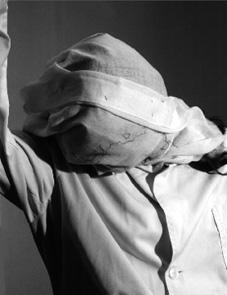That is correct!
One of the relics held by the cathedral in the town of Oviedo, in the north of Spain, is a piece of cloth measuring approximately 84 x 53 cm. There is no image on this cloth. Only stains are visible to the naked eye, although more is visible under the microscope. The remarkable thing about this cloth is that both tradition and scientific studies claim that the cloth was used to cover and clean the face of Jesus after the crucifixion.
Such a cloth is known to have existed from the gospel of John, chapter 20, verses 6 and 7. These verses read as follows, "Simon Peter, following him, also came up, went into the tomb, saw the linen cloth lying on the ground, and also the cloth that had been over his head; this was not with the linen cloth but rolled up in a place by itself." John clearly differentiates between this smaller face cloth, the sudarium, and the larger linen that had wrapped the body.

How the sudarium was wrapped around the head
The stains on the sudarium show that when the cloth was placed on the dead man's face, it was folded over, although not in the middle. Counting both sides of the cloth, there is therefore a fourfold stain in a logical order of decreasing intensity.
From the composition of the main stains, it is evident that the man whose face the sudarium covered died in an upright position. The stains consist of one part blood and six parts fluid from a pleural oedema. This liquid collects in the lungs when a crucified person dies of asphyxiation, and if the body subsequently suffers jolting movements, can come out through the nostrils. These are in fact the main stains visible on the sudarium.
These stains in the nasal area are also superimposed on each other, with the different outlines clearly visible. This means that the first stain had already dried when the second stain was formed, and so on.
The sudarium alone has revealed sufficient information to suggest that it was in contact with the face of Jesus after the crucifixion. However, the really fascinating evidence comes to light when this cloth is compared to the Shroud of Turin.
The first and most obvious coincidence is that the blood on both cloths belongs to the same group, namely AB.
The length of the nose through which the pleural oedema fluid came onto the sudarium has been calculated at eight centimetres, just over three inches. This is exactly the same length as the nose on the image of the Shroud.
If the face of the image on the Shroud is placed over the stains on the sudarium, perhaps the most obvious coincidence is the exact fit of the stains with the beard on the face. As the sudarium was used to clean the man's face, it appears that it was simply placed on the face to absorb all the blood, but not used in any kind of wiping movement.
A small stain is also visible proceeding from the right hand side of the man's mouth. This stain is hardly visible on the Shroud, but Dr. John Jackson, using the VP-8 and photo enhancements has confirmed its presence.
The thorn wounds on the nape of the neck also coincide perfectly with the bloodstains on the Shroud.
Dr. Alan Whanger applied the Polarized Image Overlay Technique to the sudarium, comparing it to the image and bloodstains on the Shroud. The frontal stains on the sudarium show seventy points of coincidence with the Shroud, and the rear side shows fifty. The only possible conclusion is that the Oviedo sudarium covered the same face as the Turin Shroud.
FULL TEXT
I have to wonder if Jesus blood type was not just rare, but one of a kind, never before or since found on this planet.
Every now and then one reads in the news that some Image of the Madonna is weeping. Sometimes these tears are blood and the news are then much more impressive. The skeptics smile; the ecclesiastical authorities evaluate the event with great prudence, with good reason, and they avoid making definite judgments; science does not get involved, and if it does, it is at the level practiced by amateurs. Then, as time passes, the event becomes less interesting, fades from memory, and is soon forgotten. Only in very rare cases is the event of such importance that it is acknowledged as true and real and is then certified as authentic and of a supernatural origin. An example is the research that was carried out on the "Weeping Madonna of Syracuse." [It was declared authentic and of supernatural origin.]
The event involves two Sacred Icons that shed tears of blood on two separate occasions. The phenomenon lasted thirty minutes and was witnessed by other persons whom Padre Pietro had immediately called. This event was recorded on video tape. Padre Pietro wiped the blood with a handkerchief and sent it to a laboratory to be tested.

This laboratory has Scientific Authority, therefore a verdict released by this laboratory is of indisputable [unquestionable] value.
After carrying out all the tests, the laboratory researchers sent Padre Pietro an official document stating, in resume,